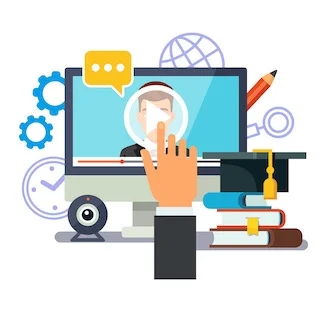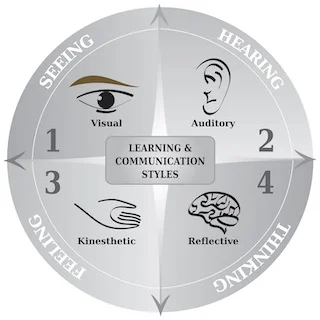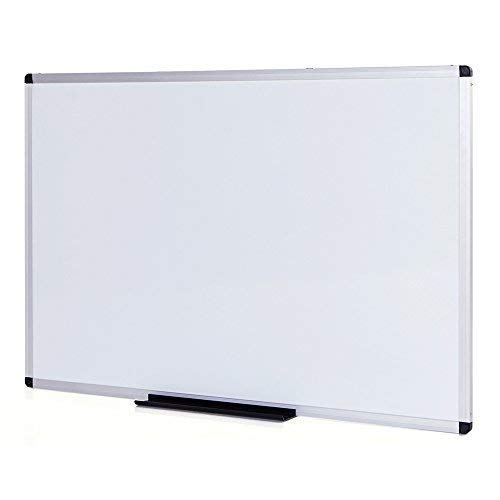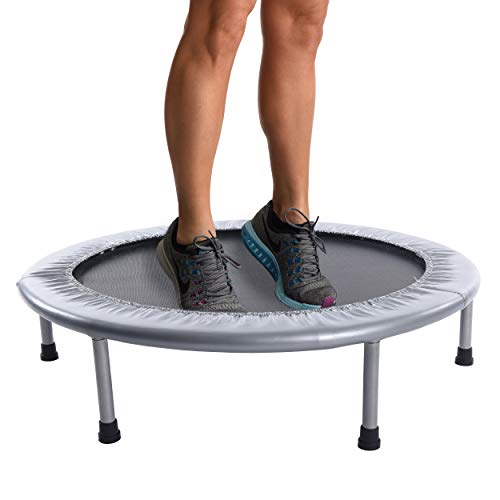Monday, July 22, 2019
welcome to the leADDership brief
A weekly newsletter for creative and innovative people, like you, with ADHD who want timely, helpful, and interesting resources
for leading and living well with ADHD.
Your Learning Style and Time Management
Understanding HOW you learn and process information is key to implementing tools and strategies that work for you and give you an advantage at work and home.
The way you learn is also the way you like to process information. When you can plan and strategize in a format that plays to your strengths, you save yourself time, make things much easier for yourself and others, and manage your daily tasks and projects like a pro.
You are a unique learner, no one else approaches learning or time-management exactly like you do. As an adult with ADHD understanding and embracing your learning style has many benefits and is worth your time and attention.
Personal and professional advantages of knowing your time-management learning style:
Increases self-awareness and self-understanding
Increases self-compassion and kindness
increases knowledge on how to use your brain best
Increases ability to leverage your unique strengths and lessen the impact of your weaknesses
Increases self-confidence, curiosity, and wonder
Increases motivation and focus
Increases your success prognosis
Gives us language to advocate for ourselves with colleagues and bosses, friends and family
Builds trust with colleagues and bosses
Improves your individual and team performance
Increases your ability to communicate effectively across learning styles
No learning style is better than or more important than another learning style. They all provide us with helpful and insightful information that benefits us greatly.
Your learning style informs how you
Perform on teams
Act in a social or group setting
Show up professionally
Think and problem solve
Relate to others
Process emotions
Work and play
And most important for today: how you manage time
RECAPPING THE THREE MOST COMMON LEARNING STYLES
Auditory learners learn best by hearing and carefully listening to external sources as well as hearing yourself talk. You are very likely to volunteer to answer questions and to actively participate in staff meetings, team discussions, etc.
Because you learn by listening and speaking and process information easily while in discussions you have a great advantage: you’re not afraid to speak up and get answers to your questions. Any form of listening or speaking is going to be the most efficient learning method for you.
As an auditory learner you are typically good at storytelling and giving speeches, you may prefer working in groups because you can talk through information, ideas, and outcomes.Kinesthetic learners are often the first one to get up and volunteer to demonstrate a new business concept or team exercise. You need to actually engage in the concept, rather than look at a diagram or listen to a speaker.
The root word “kines” means motion, and as such, you learn best by going through the motions or actually doing something. When you are actively moving you body and combining that with what you’re learning, it’s much easier for you to internalize the information.
kinesthetics learn best from seeing something first hand, watching live videos, and participating in projects. Even just combining a physical motion with a piece of information can help. You may need to pace while listening in a meeting or seminar, and you need to talk with your hands.Visual learners remember and learn what you see the most. This could include videos and pictures and spatial reasoning like charts and graphs. You often “see” words as pictures or other objects in your mind, relying on your right brain to process information.
One of the many benefits of being a visual learner is that the human brain processes visual information much faster than plain text. As a visual learner, you can take in and retain a lot of information quickly because humans are already very good at.
Visual learners prefer the use of maps, outlines, diagrams, charts, graphs, designs, and patterns. When taking notes, you are more likely to organize your notes into visual patterns and doodles. You might use charts or diagrams; you might separate your notes into different sections. Many visual learners also do well with color coding their notes with different colored pens or highlighters.
LEVERAGING YOUR LEARNING STYLE TO MANAGE TIME
Auditory learners: Once you hear something you want to remember your mind holds onto that information like a locked vault, but it also clutters your mind with more thoughts than you really need to keep track of. Here are a few ideas for increasing your time management effectiveness:
Use a voice recording app to record your to-do list, schedule, appointments, projects and goals. Here are PC Magazine’s top ten app recommendation for android and iOS. My auditory clients prefer apps that also create a transcript of your recorded message.
Leave yourself a voice mail message for the things you want to remember. This allows you to quickly and easily capture important information, so you don’t need to think about it anymore.
When faced with a more complicated problem or outcome use your recording app to talk your way through it until you have it broken down into the actions that can go on your to do list.
Use alarms on your phone to remind you of appointments, when to take your meds, daily tasks, or a reminder to pick up your kids. I have a client who uses different alarms and/or songs for different tasks. I recommend the atomic clock .
Talk through your goals, to-do list, project steps, etc. with a trusted colleague, friend, or coach.
ADHD Time Management Pro Tip:
Many of my auditory clients set alarms at the 30, 15, and 5 minute mark before they need to transition to a new task or project. The countdown helps with the transition and is a reminder to begin wrapping-up of the current project and switch focus to the next project or task.
Some auditory learners may want the additional support of a voice prompt at the 30-minute mark that says something like the this:
“You have thirty minutes before you need to leave for your meeting with your boss. It’s time to stop what you are doing, save your work, close the document, and tidy up your desk.”
“It is now 15 minutes before you need to leave for your meeting with your boss. Save what you are working on and gather your notes for your meeting.”
“You have five minutes before you need to walk out the door. Gather what you need and go.”
In the morning play your recorded to do list and/or schedule for the day so that you can hear what needs your attention for the day.
Repeat it out loud either into your recorder or the air several times. The repetition will cement into your brain.
If you are a kinesthetic-auditory learner, move as you listen and speak. The combination of movement and words will further cement the information in your brain. I had a PhD client who got through writing her dissertation by jumping on a small trampoline and saying all of her ideas and thoughts out loud first, then recorded them while pacing, then used a voice to text service to complete the paper. Whatever gets the job done.
Want free cheat-sheets, worksheets, and other resources that will help you thrive and succeed in your ADHS life? Subscribe to the leADDership brief where you get exclusive access to free downloads.
Kinesthetic learners: You learn best by doing. To improve your kinesthetic time management skills you will need to actually handle and touch things when you’re thinking and planning your way through your day or a project with multiple action steps. Here are a few ideas for increasing your time management effectiveness:
Use color coded note cards or sticky notes that can be written on and manipulated. Capture your tasks and/or project ideas on a note cards or sticky note until you have everything you need relation to the outcome you want. Sort your ideas based on their relationship to each other or perhaps topic. After you’ve sorted this way you can rearrange your cards again for logical order or priority.
Use a whiteboard to capture your tasks and ideas. Use different colored dry-erase markers for different task assignments or project ideas.
Use a tool like the Time Timer to help you recognize the passage of time
I use my apple watch as a kinesthetic timer. As a low auditory learner I will blow right by alarms but if my watch is vibrating on my wrist it’s a tactile reminder that it’s time to transition to the next task. I set alarms to my watch like auditory learners do: 30, 15, and 5-minutes before an appointment or I need to leave to get somewhere.
The apple watch also shows you your next appointment at a glance, another feature I love that helps this visual-kinesthetic learner.
ADHD Time Management Pro Tip:
To get out the door on time in the morning use sticky notes to record every step you need to take to get out the door. Put the sticky notes, in order, on your mirror or door.
Shut alarm off and get out of bed
Put on glasses
Drink water
Start coffee
Make breakfast—set alarm for 15 minutes so I don’t get distracted and lose track of time
Take a shower
Brush teeth and shave while in shower
Dry off and put on clothes you laid out the night before
Do hair and make-up if applicable
Grab lunch from fridge (that you packed the night before)
Put on shoes and coat
Grab briefcase and car keys by door
Get in car and go
To stay on track with meetings at work use sticky notes on your computer screen or the door to your office reminding you of what requires your attention today.
When I first started working from home I would leave my office for a drink of water or a coffee refill and wander out to the deck and water plants, walk around the house and pull a few weeds, wander back in and do a load of laundry or open the fridge and stare in wondering what to make for dinner. Two hours later I’d go back to my office and try and remember what I was doing.
I started putting bright neon sticky notes on my office door with “WHY ARE YOU LEAVING YOUR OFFICE NOW?” and “DOES THIS HAVE TO HAPPEN NOW?” on it. I had similar notes on the fridge, on the wash machine, on the door leading to the deck, etc.
To stay on track with a project or task that requires multiple steps and days to complete I use sticky notes or note cards and lay them out in chronological and color coded order. The first note has the start date and the last note has the completion due date on it. As each task or part of the project is completed I remove the note so that I can visually see the breakdown of time and fast approaching deadline. Seeing time diminish kicks me into a bit of an adrenaline dump so that I can focus and get stuff done.
I had no idea how long things actually took. I either over estimated because the job was tortuously boring or I underestimated because…time. My first ADHD coach tasked me with making a list of all my normal tasks, how much time I thought it took, and how much time it actually took to do it.
I was sure it took all day to do a load of laundry. When I actually timed what it took to fold and put away dry clothes it took less than 15 minutes for a normal load.
Making the bed takes less than three minutes—I was sure it took 10 minutes
Getting dressed took less than five minutes (provided I had laid out my clothes the night before)
Loading the dishwasher took less than ten minutes—I thought about an hour
Unloading the dishwasher took 10 minutes
Tidying up my desk at the end of the day took about four minutes—I thought it would take at least an hour
Reviewing my day and preparing for appointments and meetings took less than five minutes
Want free cheat-sheets, worksheets, and other resources that will help you thrive and succeed in your ADHS life? Subscribe to the leADDership brief where you get exclusive access to free downloads.
In this issue you’ll find my Task Timer worksheet.
In this short video I show you how I use visual and kinesthetic tools like sticky notes to help manage time and get the newsletter done
Visual learner time management tip: If you’re a visual learner a calendar, electronic or paper, probably works pretty well for you. Seeing your schedule and to do list helps you know where your attention needs to be on any given day or time frame. Here are a few ideas for increasing your time management effectiveness:
I recommend keeping your to-do list to no more than five things at a time and ideally two items. Our ADHD brains can get overwhelmed by too many tasks and we know that overwhelm is a buzz kill for getting stuff done. For years I kept a white board that said
“2 do 2 day” and I ONLY wrote two things I wanted to get done at a time. It was enormously helpful and upped my opportunity to succeed. I would start with two goals, accomplish them, erase them, and add two more goals. I would do this until my official day was over.Charting is another technique you might benefit from when planning things that are a little more complicated and include multiple actions. You simply record the end result in the center of a piece of paper and then start connecting related actions to the end result until you can’t think of anything else. Once everything is captured on your chart you can then begin to organize, prioritize, and delegate the actions.
Scheduling apps like ical and google are great tools. This article has great information and a list of the top ten calendar apps for 2019.
ADHD Time Management Pro Tip:
All the tips for kinesthetic learners apply to the visual learner. Scroll back up for ideas.
Because esthetics, or how things look, is often important to the visual learner be generous with your use of color coding, sharpies, colorful sticky notes, etc.
Find a calendar format that works for you. The Passion Planner has been a fan favorite of mine and many of my clients for years. It’s a calendar, journal, sketch pad, doodle pad, goal setting guide all in one. I love it.
Want free cheat-sheets, worksheets, and other resources that will help you thrive and succeed in your ADHS life? Subscribe to the leADDership brief where you get exclusive access to free downloads.
BONUS TIME MANAGEMENT HACK
I ran late to everything for years. I thought it was just a character defect I would have to live with and was constantly apologizing for being late. It was exhausting and shaming. Once I was diagnosed with ADHD and hired my first coach the first thing I wanted to work on was how to be on time.
For real.
It was a mystery to me. I could never figure it out. My ADHD brain was always fooled by my short time horizon.
Then one day my coach had me ask my husband, who is the opposite of ADHD, how he knows how to be on time.
Quick qualifier. His on time is 15 minutes early. My on time is on time. If the appointment is at ten I get there at ten, unless otherwise noted. On time. Both are true. We often have to split the difference.
So how does he know? I learned that he figured in the drive time, traffic, parking, the walk to the entrance, the walk to the actual appointment, waiting etc. He did this all intuitively. He just knew.
I. Was. In. Awe!
None of that EVER crossed my mind. I was always just trying to get there. I am still not great at figuring all of that out but I now sort of back into time. Rather than trying to decide how much time it takes to get somewhere I figure out what time I need to leave. I know it’s semantics but it helps.
A couple of examples:
Let’s say we have an early morning flight out, a common occurrence for us, rather than ask “what time do we need to be there” I ask “what time do I need to be in the vehicle ready to leave?”
Because I did the Task Timer worksheet I now know how much time it takes to get ready in the morning (about an hour and 15 minutes from rise, coffee, shower, dress, hair and make-up, shoes, and already packed suitcase). I know that if I need to be in the Jeep by 5:30 am I have to get up by 4:15 am.We moved a couple of years ago so all new dentists, doctors, stylists, etc. I google mapped all of them, noted the travel times, added traffic, parking, and walking into the office building to the travel time, then backed it up and noted when I would have to leave my house to get there on time.
I watch our grandson twice a month and he goes to a couple of toddler classes. When it is a new class I do the same as above but because they live in Chicago I add 10-15 extra minutes to the travel time.
I don’t work in an office any more but if I did I would use this method to get to work on time, get to meetings on time, get projects done on time, etc.
Auditory Learner? Click on the link below.
WHAT ELSE DO YOU NEED TO KNOW?
Free Learning Style Assessment Link Here
Tools, gadgets and resources with links below
Coach Pam














